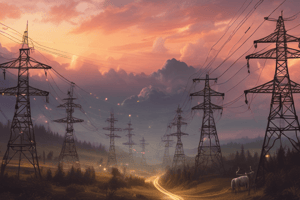Podcast
Questions and Answers
What is the main purpose of using high voltages in the primary transmission phase of a power system?
What is the main purpose of using high voltages in the primary transmission phase of a power system?
- To reduce energy loss during long-distance transmission (correct)
- To increase the voltage for final distribution
- To allow for the use of lower-grade materials in line construction
- To ensure safety at the substations
In which stage of the power system is the voltage typically generated at 11kV before being stepped up for transmission?
In which stage of the power system is the voltage typically generated at 11kV before being stepped up for transmission?
- Primary Transmission
- Power Station (correct)
- Primary Distribution
- Secondary Transmission
Which of the following voltage ranges is used for primary distribution in a power system?
Which of the following voltage ranges is used for primary distribution in a power system?
- 66 kV to 400 kV
- 11 kV to 220 kV
- 33 kV to 66 kV
- 11 kV to 132 kV (correct)
What technology is primarily used for electrical transmission over very long distances to increase efficiency?
What technology is primarily used for electrical transmission over very long distances to increase efficiency?
Which element of the power system is responsible for stepping down the voltage from primary transmission levels?
Which element of the power system is responsible for stepping down the voltage from primary transmission levels?
What type of distribution system primarily operates at voltages such as 33kV, 66kV, or 11kV?
What type of distribution system primarily operates at voltages such as 33kV, 66kV, or 11kV?
Which component of the distribution system is responsible for connecting the sub-station to the area where power is distributed?
Which component of the distribution system is responsible for connecting the sub-station to the area where power is distributed?
In which type of distribution system is the underground method preferred?
In which type of distribution system is the underground method preferred?
Which type of distribution system is NOT universally adopted due to the advantages of A.C. power?
Which type of distribution system is NOT universally adopted due to the advantages of A.C. power?
What is a distributor primarily responsible for in the distribution system?
What is a distributor primarily responsible for in the distribution system?
Flashcards are hidden until you start studying
Study Notes
Introduction to Electric Power Transmission and Distribution
- Electric power transmission involves the bulk movement of electrical energy from generation sites to substations.
- The interconnected lines facilitating this movement form a transmission network, collectively referred to as the "National Grid."
Power System Overview
- A power system encompasses generation, transmission, and distribution of electric power.
- Stages of a power system include:
- Generation of electric power
- Transmission of electric power
- Distribution of electric power
- High-voltage three-phase alternating current (AC) is primarily used for transmission.
- High-voltage direct current (HVDC) enhances efficiency over long distances (hundreds of miles).
- Electric power is transmitted at voltages of 115 kV or higher to minimize energy loss.
Layout of Power System
- Components of a power system include:
- Power Station
- Primary Transmission
- Secondary Transmission
- Primary Distribution
- Secondary Distribution
Power Station
- Bulk power generation is performed using a three-phase, three-wire system with parallel alternators.
- Typical generation voltage is around 11 kV, which is stepped up to 220 kV or 132 kV using transformers for efficient transmission.
Primary Transmission
- High voltages (66 kV to 400 kV) are utilized for power transmission via a three-phase overhead system.
- Power is delivered to substations located on the outskirts of major distribution centers.
Secondary Transmission
- Substations near cities reduce primary transmission voltage to 66 kV or 33 kV for secondary transmission.
- This system also operates using a three-phase wire configuration.
Primary Distribution
- Transmission lines lead to large substations, distributing power to smaller secondary substations across the load area.
- Voltage levels for primary distribution range from 11 kV to 132 kV.
Secondary Distribution
- Low-voltage networks extend throughout streets and rural areas.
- Connections to individual consumers typically use a three-phase, four-wire system, providing either 440 V (three-phase) or 220 V (single-phase).
Introduction to the Distribution System
- Distribution of electric power is critical for accessibility to various consumer needs.
- A distribution system must ensure economical and efficient power delivery.
- The distribution system divides into three parts:
- Feeders
- Distributors
- Service mains
Distribution System Types
- The distribution system channels electrical power from bulk sources to consumers.
- Types of distribution include:
- High voltage or primary distribution (33 kV, 66 kV, 11 kV)
- Low voltage or secondary distribution (400/230 V)
Important Terms in Distribution System
- Feeder:
- Conducts electricity from substation or generating stations to distribution areas.
- Carries high currents to feeding points.
- Distributor:
- Conductor that supplies power to consumers and varies current loading along its length.
- Service Mains:
- Small cables connecting distributors to consumer terminals.
Classification of Distribution Systems
- By Nature of Construction:
- Overhead distribution system (cheaper)
- Underground distribution system (used in densely populated areas)
- By Nature of Current:
- D.C. distribution system
- A.C. distribution system (universally preferred due to advantages of AC over DC)
- By Number of Wires:
- 2-wire DC system
- 3-wire DC system
- Other configurations depending on usage
Studying That Suits You
Use AI to generate personalized quizzes and flashcards to suit your learning preferences.



